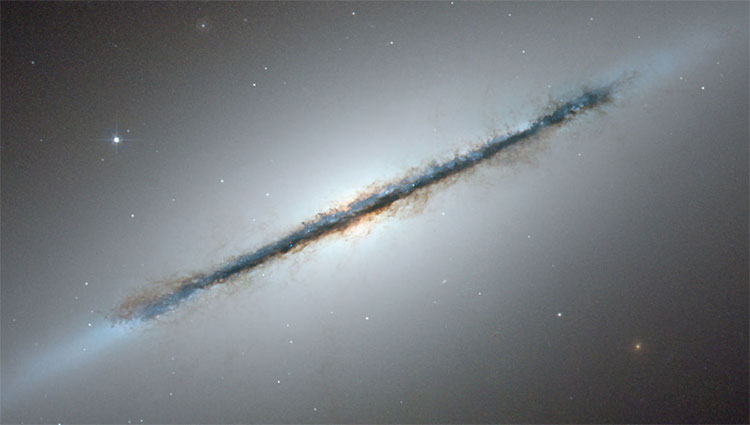NASA's Spitzer telescope spotted a new galaxy
Spitzer Space Telescope has discovered galaxy NGC 5866 about 60,000 light-years in diameter - more than half the diameter of the Milky Way where people live.
NASA's Space Spitzer Space Telescope (NASA) has discovered a new galaxy - named NGC 5866 by scientists, located 44 million light-years from Earth.
Galaxy NGC 5866 is about 60,000 light-years in diameter - more than half the diameter of the Milky Way where people are living.
In satellite images released by NASA on August 7, the long red beam at the center of the image is NGC 5866. When viewed from Earth, scientists can only see the edge of NGC. 5866 and most of the galaxy's structural features are invisible.

Galaxy NGC 5866 diameter about 60,000 light years.
The Spitzer telescope has discovered that infrared and red light in this image corresponds to infrared wavelengths that are usually emitted from dust.
With a thickness like soot or a thick layer of smoke, dust absorbs light from the stars, then replays the light at a longer wavelength, even in infrared.
According to NASA, the edges that do not emit dust from NGC 5866 indicate that there is a very flat ring of dust or dust around the outer area of the galaxy. Efforts to understand the history of formation and shape of NGC 5866 are considered a challenge for scientists by the direction of this galaxy.
The Spitzer telescope recorded the above image in an "impromptu" mission that ended in 2009. The colors represent three infrared wavelengths captured by Spitzer's infrared camera device.
Blue light corresponds to Spitzer's observations at a wavelength of 3.6 microns, produced primarily by stars; green corresponding wavelength 4.5 micron; Red also corresponds to 8 microns.
NASA's Spitzer telescope was commissioned on August 25, 2003, providing astronomers with a unique perspective on the universe through infrared lenses, while enabling scientists to close to the space that optical telescopes cannot reach.
Under the plan, Spitzer will end its mission on January 30, 2020, after nearly 16 years of exploring the universe under infrared light.
- Admire 10 priceless photos taken by NASA's Spitzer telescope
- Spitzer captured a strange galaxy
- Eyes glow in the universe
- Detecting the blue galaxy
- Telescope 'travel' back in time 13.2 billion years
- Spitzer Space Telescope's 10-year-old birthday
- The galaxy was discovered when the universe was 650 million years old
- New discovery about galaxy formation
- The correct distance from Earth to the nearest galaxy
- Detecting a star exploding behind a cloud of dust
- Detecting giant galaxy cluster 8.5 billion light-years from Earth
- Spitzer discovered a strong collision between the two planets
 Van Allen's belt and evidence that the Apollo 11 mission to the Moon was myth
Van Allen's belt and evidence that the Apollo 11 mission to the Moon was myth The levels of civilization in the universe (Kardashev scale)
The levels of civilization in the universe (Kardashev scale) Today Mars, the sun and the Earth are aligned
Today Mars, the sun and the Earth are aligned The Amazon owner announced a secret plan to build a space base for thousands of people
The Amazon owner announced a secret plan to build a space base for thousands of people